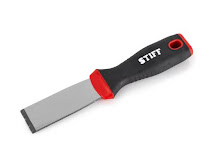I haven't posted in a while, but I've been juggling a number of projects that are in various stages of completion and I prefer to report on the job once it's completed. With that said, I did officially finish a job that has been on going for months in little chunks because it is so terrible that I can only handle about an hour of it at a time. The elephant I'm talking about was the removal of many, many years of bottom paint so that I have a bare hull.
I'm certain that the bottom has been stripped bare in the past because I found an epoxy barrier coat underneath the layers of anti fouling paint (I doubt they came that way from the factory), but I'd guess it's been at least 20 years and the amount of paint on the bottom was just staggering.
When I began last fall, I already had 2 gallons of chemical paint stripper on hand from other projects (different manufacturers) so I thought I would start with the rudder and see which one worked the best. I quickly found out that these strippers work on 1-3 coats pretty well, but not so much when you have 15-20 coats. Both strippers basically made a big mess and still left me with most of the paint on the boat. The next method I tried was a sander with 40 grit paper. I already knew that this would be a disaster as well, but I'm not too bright and don't learn from past mistakes (Alberg 35). Even with a big dust collector attached and a full face respirator, it made a big red cloud of toxic dust that would have taken years off my life and polluted the property where I store the boat.
I spent hours googling in hopes of finding an easy solution and aside from hiring someone to do the job for me, I found that most ultimately resort to a scraper and hours and hours of backbreaking work. I tried a few different types:
- Carbide Furniture Scraper - works for a few coats but was not up to the task I had. Also, it was awkward to use while crouching underneath the boat.
- Standard Paint Scraper - the blade was too flexible and couldn't really dig through and under all the layers.
- 2" Mortising Chisel - too sharp on the corners and tended to gouge badly. It did get all the layers of paint though.
I spent some quality time at Lowes and found that the Warner Pro 1-1/4" putty knife was just about right. It was somewhat sharpened and had a thick blade that didn't bend when trying to get through the paint, but the edges were rounded enough so it didn't gouge the underlying fiberglass.
 |
| First session's progress |
Today I finally finished off the entire bottom and I am sooo glad it's done. Well, sort of... I applied some fairing compound along the keel seam and will have to sand that down along with a light sand over the rest of the hull, but in comparison, it's not so bad. Once that's done, I'll apply a few more barrier coats before bottom paint next spring/early summer when I launch.
 |
| It may not look pretty, but that's as bare a bottom as I can get. |




Nice work. I've throughly enjoyed reading about your adventures. So much so, now I'm looking for a Niagara 35. My father worked at Hinterholler Yachts when I was a child. Great memories. Our family had a Niagara 26.
ReplyDeleteHi Christopher, glad you are enjoying my ramblings... I need to be more consistent and post more frequently.
DeleteGlad to find your blog. We're enjoying reading it. Our Niagara is hull #139 (classic version), she's our exploration platform, now home, and has always been a project eternally underway over the 20+ years she's been ours...
ReplyDeleteWe're about to take on rebedding the fixed windows (side lights). Have you taken these on yet?
Thanks in advance for any insights you care to share or point us to the blog entry.
Cheers, J&S
Thanks, I do these blogs so I can refer back and remember what I did, but it's always nice to hear that it's helpful to others as well. I did re-bed one of the fixed port lenses this spring because it was not installed when I bought the boat. The lense was just a matter of cleaning up the flanges on both the frame and the acrylic and then using Dowsil 795 as a bedding compound/adhesive. I didn't re-bed the frame though and have read (and watched on youtube) that it can be a bit of a nightmare. See https://www.youtube.com/watch?v=HVYLVM6tegY&t=604s for a deep dive.
Delete